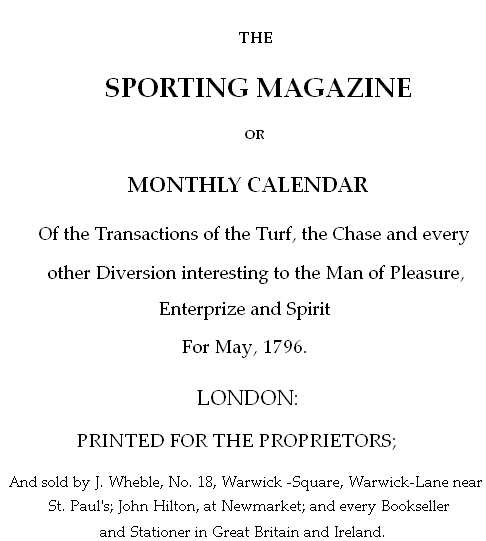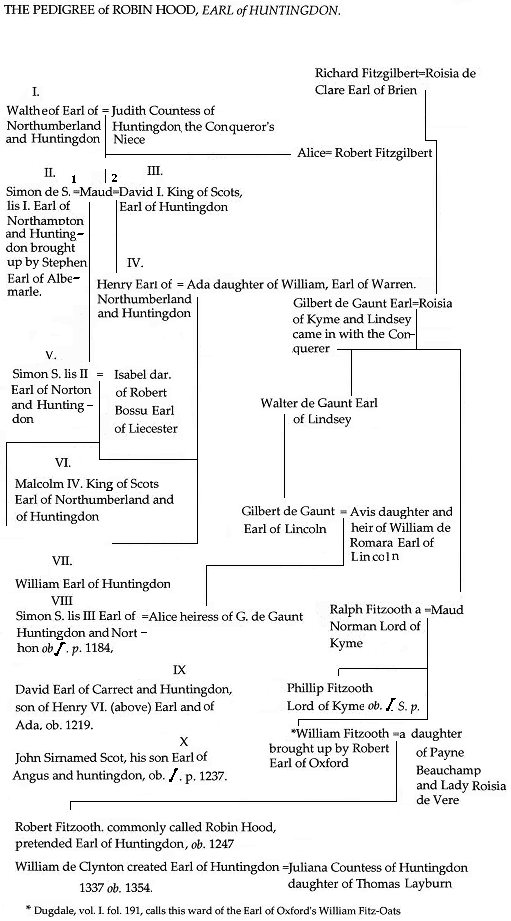Sporting Magazine
76
Life of Robin Hood
During the reign of King Richard the First, we find mention made of Robin Hood, at which period the intestine troubles were very great, and the country every where infested with out-laws and banditti; among whom none were so famous as this Sylvan hero and his followers, whom Stow, in his-Annals, styles renouned thieves. The personal courage of this celebrated outlaw, his skill in archery, his humanity, and especially his levelling principle, of taking from the rich and giving to the poor, have ever since rendered him the favourite of the common people.
Sir Edward Coke, in his third institute, page 197 speaks of Robin Hood, and says, that men of his lawless profession were from him called Roberdsmen: he says, that this notable thief gave not only a name to these kind of men, but mentions a bay on the Yorkshire coast, called Robin Hood’s Bay. He farther adds, that the statute of Winchester, 13th of Edward I and another statute of the 5th of Edward III. were made for the punishment of Roberdsmen, and other felons.
Who was the author of the collection, called Robin Hood’s Garland, no one has yet pretended to guess. As some of the songs have more of the spirit of poetry than others, it is probably the work of various hands that it has from time to time been varied and adapted to the phrase of the times, is certain.
In the vision of Pierce Plowman, written by Robert Longland, a secular priest, and fellow of Oriel College, and who flourished in the reign of Edward III. is this passage:
I cannot perfitly my Paster Noster, аs the priest it singeth ;
I can rimes of Robinhood and Randal of Chester.
Drayton in his Poly-Olbion, song-xxvi. thus chàracterises him :
From wealthy abbots chests, and churches abundant store,
What often times he took he shared amongst the poor ;
No Lordly bishop came in lusty Robin’s way,
To him before he went but for his pass must pay ,
The widow in distress he graciously relieved,
And remedied the wrongs of many a virgin grieved.
Hearne, in his Glossary, inserts a manuscript note out of Wood, containing a passage cited from
77
John Major, the Scottish historian, to this purpose; that Robin Hood was indeed an arch-robber, but the gentlest thief that ever was: and says he might have added, from the Harlein MSS. of John Fordun’s Scottish Chronicle, that he was, though a notorious robber, a man of great charity.
The true name of Robin Hood, was Robert Fitz-ooth, the addition of Fitz, common to many Norman names, was afterwards often omitted or dropped: the two last letters t h being turned into d, he was called by the common people Ood or Hood. It is evident he was a man of quality, as may be seen by a pedigree in Dr. Stukeley’s Paloeographia Britanniae: John Scot, 10th Earl of Huntingdon, dying anno1237, without issue, R. Fitz-ooth, was by the female line, next heir to that title, as descended from Gilbert de Gaunt, Earl of Kyme and Lindsey. The title lying dormant* during the last ten years of his life, there could be nothing unreasonable or extraordinary in his pretensions to that honour. The arms of Robin Hood were gules, two bends engrailed or. In the old garland, he is said to have been born at Loxley, in Staffordshire; and in a shooting match+ made by the King and Queen, being chose by the latter for her archer, she calls him Loxley: a custom very common in those days to call persons of eminence by the name of the town where they were born.
* The title lay dormant 90 years after Robert’s death; namely till the year 1337, when William Lord Clinton was created Earl of Huntingdon.
+ On this occasion we are told, that Robin Hood was dressed in scarlet, and his men in green; and that they all wore black hats and white feathers.
It does not appear that our hero possessed any estate; perhaps he or his father might be deprived of that on some political account; attainders and confiseations being very frequent in those days of Norman tyranny and feudal oppression. In the 19th of Henry II. when the son of that king rebelled against his father, Robert de Ferrers manned his castles of Tutbury and Duffield in behalf of the Prince. William Fitz-ooth, father of our hero, (suppose him connected with the Ferrers, to which his dwelling at Loxley* seems to point,) might suffer with them in the consequences of that rebellion, which would not only deprive the family of their estates, but also of their claim to the Earldom of Huntingdon. From some such cause, our hero might be induced to take refuge in those woods and forests, where the bold adventurer, whether flying from the demands of his injured country, or to avoid the ruthles hand of tyrannic power, had often found a safe and secure retreat.
Tutbury, and other places in the vicinity of his native town, seems to have been the scene of his juvenile frolics. We afterwards find him at the head of two hundred strong resolute men, and expert archers, ranging the woods and forests of Nottingham, Yorkshire, and other parts of the north of England.+
Charton, in his history of Whitby Abbey, page 146, recites, ‘ That in the days of Abbot Richard, this freebooter, when closely pursued by the civil or military power, found it necessary to leave his usual haunts, and retreating across the moors that surrounded Whitby, came to the sea coast,
* The Ferrers were Lords of Loxley.
+ Besides many other places, the following are particularly mentioned. viz. Barnsdale, Wakefield, Plompton Park, and Fountain’s-Abbey.
79
where he had always in readiness some small fishing vessels ; and in these, putting off to sea, he looked upon himseif as quite secure, and held the whole power of the English nation at defiance. The chief place of his resort at these times, and where his boats were generally laid up, was about six miles from Whitby, and is called Robin Hood’s Bay. Tradition further informs us, that in one of these peregrinations he, attended by his lieutenant, John Little, went to dine* with Abbot Richard, who having heard them often famed for their great dexterity in shooting with the long-bow, begged them after dinner to shew him a specimen thereof; when to oblige the abbot, they went up to the top of the abbey, whence each of them shot an arrow, which fell not far from Whitby Laths, but on the contrary side of the lane. In memory of this transaction, a pillar was set up by the abbot in the place where each of the arrows fell, which were standing in 1779; each pillar still retaining the name of the owner of each arrow. Their distance from Whitby Abby is more than a measured mile, which seems very far for the flight of an arrow ; but when we consider the advantage a shooter must have from an elevation, so great as the top of the abbey, situated on a high cliff, the fact will not appear so very extraordinary. These very pillars are mentioned, and the fields called by the aforesaid names in the old deeds for that ground+, now in the possession of Mr. Thomas Watson. It appears by his epitaph, that Robert
*Possibly without invitation.
+ That each of the arrows of these renowned shooters fell, as above described, is probable; but that they were shot from some other place than the top of the abbey is equally probable.
Fitz-ooth lived 59 years after this time (1188); a very long period for a life abounding with so many dangerous enterprizes, and rendered obnoxious both to church and state. Perhaps no part of English history afforded so fair an opportunity for such practices, as the turbulent reigns of Richard 1. King John, and Henry III.
Hubert, archbishop of Canterbury and chief justiciary of England, we are told, issued several proclamations for the suppressing of outlaws ; and even set a price on the head of this hero. Several stratagems were used to apprehend him, but in vain. Force he repelled by force; nor was he less artful than his enemies. At length being closely pursued, many of his followers slain, and the rest dispersed, he took refuge in the priory of Kirk lees, about twelve miles from Leeds, in Yorkshire, the prioress at that time being his near relation. Old age, disappointment, and fatigue, brought on disease; a monk was called in to open a vein, who, either through ignorance or design, performed his part so ill, that the bleeding could not be stopped. Believing he should not recover, and wishing to point out the place where his remains might be deposited, he called for his bow, and discharging two arrows, the first fell in the river Calder, the second falling in the park, marked the place of his future sepulture. He died on the 24th of December, in the year 1247 *, as appears by the following epitaph, which was once legible on his tomb, in Kirklees park; where, though the tomb remains,
*Supposing him twenty-one years of age, when on his visit to Abbot Richard at Whitby, he must at this time have been at least in his eightieth year.
80
yet the inscription hath been long obliterated. It was, however, preserved by Dr. Gale, dean of York and inserted from his papers by Mr. Thoresby in his Ducat. Leod. and is as follows :
Hear, underneath dis latil stain,
Laiz Robert Earl of Huntington;
Nea Archir ver az hie sa geud,
An pipi kauld im Robin Heud :
Sick, utlawz az hi an iz men,
Vil England nivir si agen.
Obit 24 Kal. Dekembris, 1247.
In a small grove part of the cemetry formerly belonging to this priory, is a large flat grave-stone, on which is carved the figure of a Cross de Calvary, extending the whole length of stone, and round the margin is inscribed in monastic characters :
+ Dovce : Ihu : de: Nazareh : Donne : Mercy : Elizabeh : de . Stanton ; Prioris : de : Cette Maison*.
The lady whose memory is here recorded, is said to have been related to Robín Hood, and under whose protection he took refuge sometime before his death. These being the only monuments remaining at the place, make it probable, at least, that they have been preserved on account of the supposed affinity of the persons over whose remains they were erected.
R. Hood’s mother had two sisters+, each older than herself. The first married Roger Lord Mowbray; the other married into the family of Wake. As neither of these could be prioress of Kirklees, Elizabeth Stanton might be one of their descendants.
* This Norman inscription shews its antiquity,—Robin Hood’s ancestors were Normans, and possessed the Lordship of Kyme, in Lincolnshire. There is a market- town in that county called Stanton.
+ Dr. Stukeley.
In the churchyard of Hathersage, a village in Derbyshire, were deposited as tradition informs us, the remains of John Little the servant and companion of Robin Hood. The grave is distinguished by a large stone, placed at the head, and another at the feet; on each of which are yet some of the remains of the letters J. L.

|

